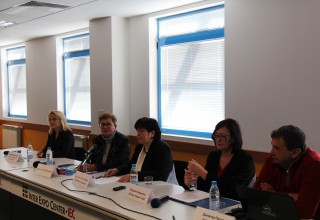Minister Baltova: Low-cost airlines change tourist supply and demand
There is an undeniable connection between tourism and transport. The more well-developed access to a country is, the more popular it becomes. That is why low-cost airlines are a decisive factor in the selection of a tourist destination. This was stated by the Minister of Tourism Assoc. Prof. Stela Baltova during the discussion “How low-cost airlines change tourist supply and demand”, organized by the Ministry of Tourism in the second day of the 34th International Tourist Fair HOLIDAY/SPA EXPO. Deputy Minister Irena Georgieva also took part in the event.
Data from the International Civil Aviation Organisation (ICAO) shows that in 2016 over 1 billion persons were carried by low-cost companies. Their flights are essential for the development of Bulgarian tourism, because most of the trips of international tourists in Bulgaria in 2016 – 4,620,168, or 56% of all trips – are from countries which are not neighbours of Bulgaria. Tourists from those countries arrive mainly with air transport, in the words of Stela Baltova. She emphasized that generally the effect of penetration of low-cost airlines allows more tourists to make at least one trip. Moreover, higher satisfaction with the tour is achieved as the saved money on a flight ticket can be used for a higher class tourist services. The attraction of the destination should meet the actual needs of the market and the natural needs of tourists – vacation, sport, health, etc. This is in line with the aspiration of all Bulgarians to make the country a competitive destination and an example of sustainable tourism, summarized minister Baltova.
In her statement Mariana Kirilova, marketing manager of Sofia Airport EAD, pointed out that the effect of the low-cost airlines market promoted higher accessibility and connectivity of destinations. Consumers are presented with more options to choose an airline, airport, airport, ticket prices. Data from the airport shows that in the first month of 2017 the record 468,968 passengers passed through it, 43% up on January 2016. Passengers going through Terminal 1 increased by 69%, reaching 216,000 persons and those passing through Terminal 2 increased by 28% as a result of the transfer of some flights from the old to the new terminal in mid-January this year. In January passengers travelling by charter flights increased by 27% compared with the same month of 2016 and their number in domestic routes marked a 13% growth YoY. The total number of taking off and landing aircrafts at Sofia Airport reached 4,529 in January 2017, marking an increase of 25%. The share of flights on regular international and domestic routes is 87%, and charter flights, cargo and business aircrafts split 3% each.
Mariana Kirilova forecast that more than half of the traffic via the airport in 2017 will be used by low-cost airlines for trips. According to a survey of the airport, 80% of the tourists passing through Terminal 1 in winter 2016 opted for direct regular routes of low-cost carriers and only 20% used charter flights. Bulgarians residing permanently abroad accounted for 20% of all tourists who came in the winter in the country, the other 80% are foreigners from Great Britain – 68%, Israel – 9%, Italy – 5%, the remaining are from Germany, France, the Netherlands, and Denmark.
In the summer of 2016 via Terminal 1 87% of the total tourist flow used low-cost carriers and only 3% travelled with charter flights, the remaining 10% used other means of transport. 94% of Bulgarian tourists who flew in the summer of 2016 via Terminal 1 visited Italy (29%), Spain (22%), Great Britain (13%) etc.
Dimitar Popov, member of the Management Board of the Association of Bulgarian Tour operators and Tourist Agents (ABTTA) commented that in the conditions of a wider penetration of low-cost-companies in Bulgaria it was necessary to re-consider the opportunities for weekend tourism, city breaks and a new term that emerged this winter season – ski weekend.
Denitsa Milosavlievich, marketing expert in business development in Fraport Twin Star Airport Management AD announced that in summer 2016 there was an unprecedented rise in flights to the two sea airports Varna and Burgas. She emphasized that for development and creation of a common tourist product the common efforts of municipalities, tourist associations, airports and airlines are needed. In 2016 Varna Airport served over 1.l6 million passengers, a 21% rise on the previous year. The visitors are mainly from Germany, Russia, Poland, Great Britain, Israel, etc. Burgas Airport welcomed over 2.8 million tourists in 2016, a 22% rise on annual basis, and there are many foreigners from Russia, Germany and Great Britain.
After the discussion minister Baltova took part in the ceremony for presenting the traditional awards of Tourism and Leisure magazine, held in the context of the fair, and presented a certificate to the director of the Palace in Balchik Zheni Mihaylova in the category “Innovation in Cultural Tourism“.







